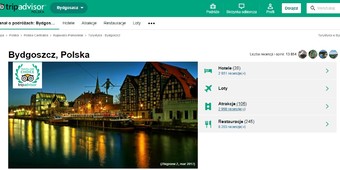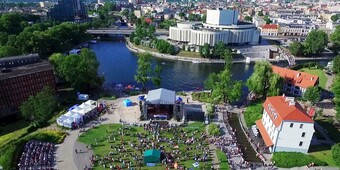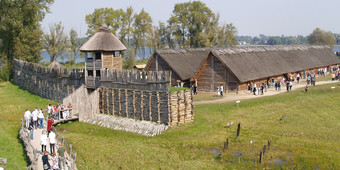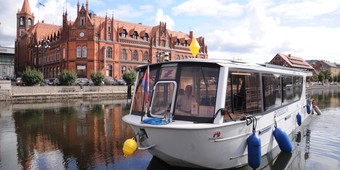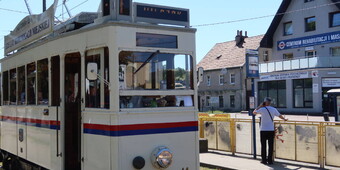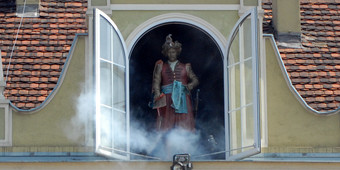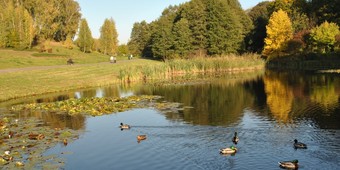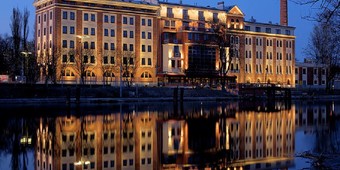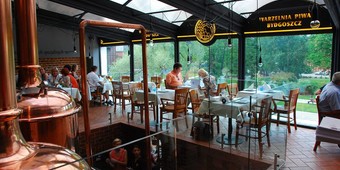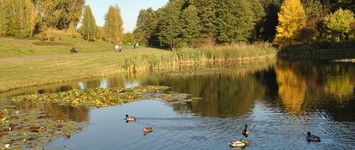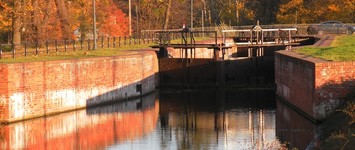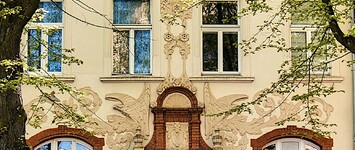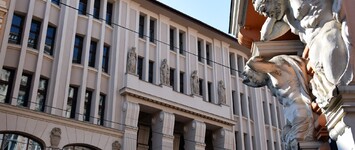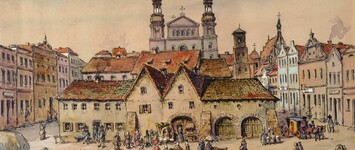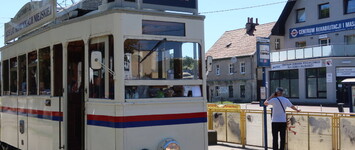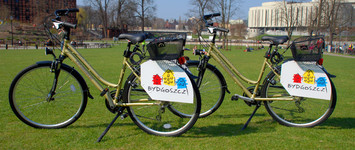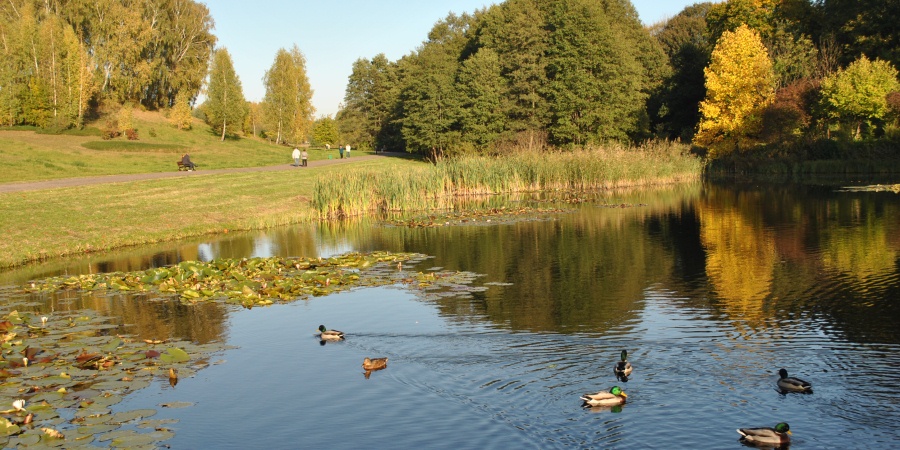
Botanical Garden, Bydgoszcz, fot. R.Sawicki
Time: approx. 3 hours (park in Myślęcinek, additional 2 hours)
In Bydgoszcz, the first gardens were established in monasteries and suburbs, where they were owned by affluent townsmen.
During the period of the partitions of Poland, the Society for Beautification of the City of Bydgoszcz and its Environs (active 1832-1898) made the city greener by planting new trees and creating greenery in town squares.
During the interwar period, Bydgoszcz, Katowice and Warsaw had been known as the greenest cities of Poland. Since 2004, works have been underway on the project “Restoration of Tree Alleys in the City Centre based on the plantings from the 1920’s and 1930’s”. In terms of green areas, the city is only behind Warsaw.
We start our walk at the water tower in 1 Filarecka Street (Museum of Waterworks). The Henryk Dąbrowski Park, stretching on a steep terraced hill, was established on the initiative of President of Bydgoszcz District, Carl von Wissmann, thus it was known initially as Wissmann’s Hill. The park featured ponds and a waterfall connecting them. It was very popular from the early 20th century, when a water tower with a lookout terrace offering a panoramic view of the city was erected on the top of the hill. In 1920, the park was named after Gen. Henryk Dąbrowski, who stopped on this site in October 1794 (an obelisk commemorating this event, made by Krystyna Panasik, was erected in 1995). Revitalization works have continued in this place since 2002. The park features several national natural landmarks, including pedunculate oak, northern red oak, ginkgo, Turkestan elm, small-leaved linden, and white willow. New plantings added in 2013 included Caukasian oak “Concordia”, Japanese Pagoda Tree, and cornus controversa “Variegata”.
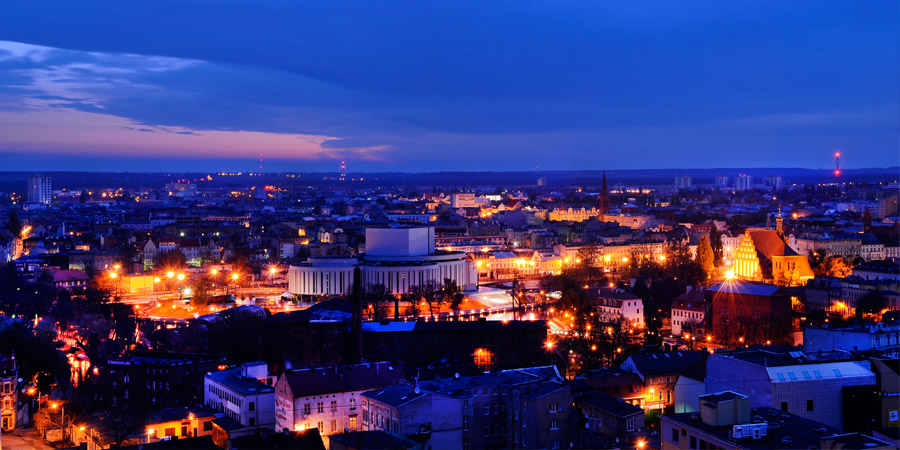
view from the water tower, Bydgoszcz, fot. R.Sawicki
Did you know that...
Artist Zbyszko Piwoński turns dead tree trunks into sculptures in the streets of Bydgoszcz. They can be seen at 30 Gdańska Street, “Woman in Doves”, in Mickiewicza Avenue, “Awakening of Elves” (both made in 2006), and in Słowackiego Street, “We Will Play in Just a Moment” (2010). There is also a monument of Dwarves made in Konopnicka Street by Mirosław Kufel (2012).
We continue our trip, going down towards the Old Town by Terasy Street all the way to the New Market Square. We take Wąska Street to the Wełniany Market Square. After that, we go through a small passage between the tenement houses no. 6a and 7, through a lattice footbridge, and enter Mill Island. Situated in the heart of the city, this green oasis encourages relaxing by the humming canal of Międzywodzie, admiring the Bydgoszcz Venice, and taking a walk along paved alleys lined with chestnuts, lindens and willows planted in the 19th century. The central part of the island is occupied by a playground for children.
Did you know that...
At the beginning of the 1950’s, in a square close to the water tower, the communist authorities built a wooden structure with a radio jamming device for disrupting the signal of radio stations from Western Europe. On November 18, 1956, residents of Bydgoszcz burnt the radio station mast. Participants of this campaign were subjected to repressions, but the tower was not rebuilt. This event is commemorated by a plaque installed in 1996.
We leave Mill Island, heading towards the Old Market Square by Ku Młynom and Niedźwiedzia Streets. We cut through the Old Market Square and take Mostowa Street to the crossing of Gdańska and Jagiellońska Streets. A small square dating from the second half of the 19th century, featuring a wayside shrine with a statue of Our Lady, is seen close to the old Church of the Poor Clares at 2 Gdańska Street. Going through Gdańska Street, we reach Wolności Square. In its proximity, is the Kazimierz Wielki Park, which is the oldest park in the city. Here, the Poor Clares used to have their garden, which was outlined in the convent in the 16th century.
Did you know that...
The convent garden was slightly larger than the park, reaching the present-day 3 Maja Street. It featured a fishing pond, an orchard with fruit trees, vegetable garden, and a garden with medicinal plants, which in the 16th century included such plants as common wormwood, horseradish, summer savory, garlic, mustard plant, dill, mint, and nettles. The nuns used them to make medicines administered to the needy gathering at the convent lazaretto.
In 1835, after the convent was disbanded, the garden was turned into the District Park (Regierungs Garten) that was owned by the District Office, situated at what is now 3 Jagiellońska Street (presently, the Regional Office). The garden was open only to the city officials and closed to other residents of the city. In 1900-1901, it was changed to the Municipal Park (Stadt Park), redesigned by Paul Meyerkamp, and opened to the public. In July 1909, the “Deluge” Fountain was unveiled. Trees of the park had suffered during the Second World War, when bunkers were excavated there. Since 1945, the park has been named after King Casimir the Great. It is a very charming place with two ponds (a swan house can be seen in the middle of one of them), the restored fountain and a playground for children. During hot summer days, one can hide in the shade of old trees. Rare specimens of trees can be seen in the park, including bald cypress, London plane, pedunculate oaks, and ginkgo. The park looks particularly beautiful in the autumn.
The park borders Wolności Square featuring a monument commemorating the Red Army soldiers who died during the battles for liberation of the city, erected in 1945 (designed by Jan Kossowski). In 1990, it was renamed the Freedom Monument. In 1888-1919, the site was occupied by the equestrian statue of Wilhelm I (designed by Alexander Calandrelli).
We continue our walk, turning from Wolności Square to Gimnazjalna Street and further, through its extension, which is Libelta Street. In front of us, we can find the Jan Kochanowski Park, a landscape park established in 1901 by Konrad Neumann (the then director of the Bydgoszcz Municipal Gardens). Scenic, meandering paths, vast green areas, a playground for children and a myriad of tree and shrub varieties make the park is one of the favourite recreation sites for the locals. The Academy of Music is located in the vicinity of the park. The music heard from the building makes walking even more pleasant. In August 1927, a monument to Henryk Sienkiewicz (designed by Konstanty Laszczka) was unveiled, which was damaged during the Second World War. The current statue of the writer was erected on the same site in May 1968 (made by Stanisław Horno-Popławski). In 1970, a decorative plaque with a broken rose was installed in the park. It commemorates the death of fifty secondary school pupils from the Male Secondary School, functioning during the interwar period, who were killed on September 5, 1939 (designed by Józef Makowski). The most frequently visited statue in the park is the Archer Lady, erected in 1960 at a park square across from the Polish Theatre. During the 1970s, on the initiative of Andrzej Szwalbe, the head of the Pomeranian Philharmonic, work started on establishing a music district. The Park and the area surrounding the Pomeranian Philharmonic was successively adorned with statues of composers and virtuosos (F. Chopin, I. Paderewski, S. Moniuszko, H. Wieniawski, G. Bacewicz).
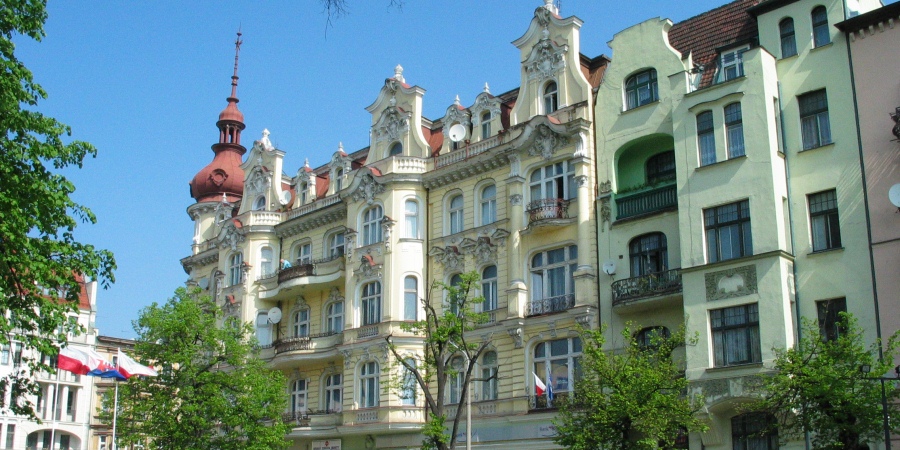
Wolności Square, Bydgoszcz, fot. R.Sawicki
Did you know that...
In 1946, on the occasion of the 600th anniversary of Bydgoszcz, the Kazimierz Wielki Park and the surrounding buildings hosted the Pomeranian Exhibition of Industry, Crafts and Trade. It attracted more than a thousand exhibitors and 120,000 visitors between July and September of that year. The event is commemorated by a brick arch.
There are also several trees designated as national natural landmarks seen in the park, including a black poplar, alnus cordata, red horse-chestnut, and pedunculate oak.
Going through the park, we reach Mickiewicza Avenue and head to Weyssenhoffa Square. The corner is occupied by the former Botanical Garden, which was opened in 1930 and designed by Marian Güntzel, director of the Municipal Gardens. The garden was surrounded with fence and divided into the following departments: systematic, biological, crop plants, and ornamental plants. The latter featured a rectangular square, in the middle of which was a sundial mounted on a raised platform, with small statues of girls in the corners, depicting the seasons. A bas-relief map of Bydgoszcz could be seen in the southern part of the square, on the fence wall. In 1995, the Botanical Garden was designated as a national natural landmark. It was handed over to the Kazimierz Wielki University in 1999. These days, the garden has more than 300 specimens of trees and shrubs, featuring unique and relict varieties. Foreign species originate primarily from Asia and North America, but there are also trees and shrubs from the Mediterranean regions, including North Africa. Half of the plantings come from Europe. The garden has fifteen varieties of trees and shrubs that are under protection (including shrubby birch, dwarf birch, mezereon, Swiss stone pine, European dwarf cherry, and European bladdernut). Between April and late autumn, the Park is open to the public through its main entrance at the corner of Niemcewicza Street and Weysenhoffa Street. In winter, the park can be accessed only from the Kazimierz Wielki University.
Now, we can choose either of two options for a further walk.
We can continue our trip to the Wincenty Witos Park in the city centre (Option I) or to Myślęcinek, which is the biggest park in Poland (Option II).
Option I:
Going out through the main exit of the Botanical Garden, we head to St Vincent de Paul Basilica Minor, whose dome towers over this part of the city. We take the wide Ossolińskich Avenue, outlined in 1903 and lined with oaks, heading to its crossing with 9 Markwarta Street. Ossolińskich Avenue features the Oak Lane of Honour. A magnolia (natural landmark), which is one of the most magnificent and oldest in Bydgoszcz, grows at 12 Ossolińskich Avenue. On the left side, we take a look at the narrow Szymanowskiego Street shaded with Swedish whitebeams (the tree alley is a natural landmark).
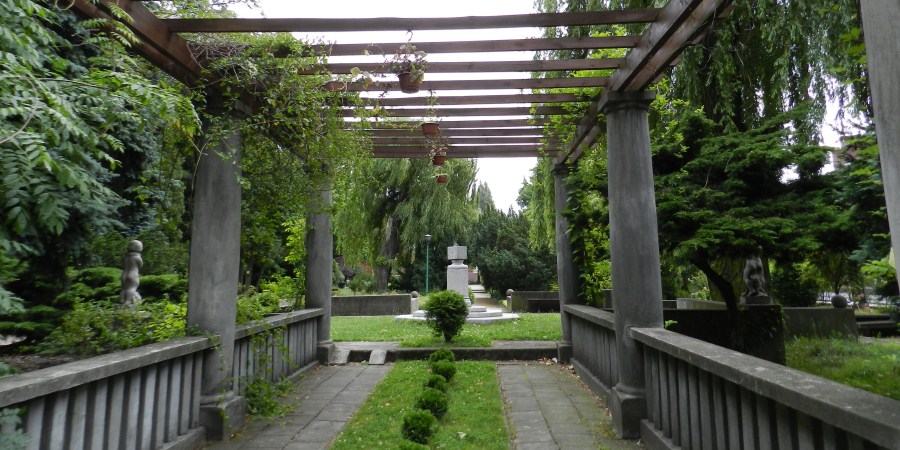
Botanical Garden, Bydgoszcz, fot. bci
Did you know that …
The Oak Lane of Honour is located in Ossolińskich Avenue. Some of the trees are dedicated to such notable people as Pope John Paul II, painter and graphic artist Leon Wyczółkowski, writer Tadeusz
Nowakowski, and cryptologist Marian Rejewski.
Now we face the Wincenty Witos Park, established in the 1950’s on the site of a Protestant cemetery (which is commemorated by an obelisk erected in 2007). The park features some impressive old trees. Some of the most prominent specimens include the city’s biggest chestnut, 540 cm in circumference (a natural landmark), very rare catalpa bignonioides with beautiful leaves, and another pedunculate oak designated as a natural landmark. In 2013, a hornbeam alley was planted. A bust of the patron (made by Witold Marciniak) was erected in the southern part of the park in 1984. A band shell, built in 1956, is seen in the middle of the park.
Did you know that …
According to the original concept, the Jan Kochanowski Park was supposed to be part of the garden district designed in the early 20th century. The romanticism of the design was highlighted by the location of the park between Goethego Street (presently 20 Stycznia 1920 Street) and Schillera Street (presently Paderewskiego Street).
Option II:
We go back by Mickiewicza Avenue to Gdańska Street, which we can do either by walking or taking a tram, heading towards the “Myślęcinek” Forest Park of Culture and Recreation. The park was created in stages from 1972. This recreation and park zone was designed by engineers Aleksander Pietrzak and Edward Bartman. It was incorporated into the city limits of Bydgoszcz in 1977. These days it is the biggest municipal park in Poland, stretching over 830 hectares. More than half of the park features woods with pine trees, lindens, oaks, hornbeams, and beeches. Hiking and jogging paths, Nordic walking trails, biking and inline skating trails crisscross the area. A ski slope with a lift is open in winter. Forest clearings encourage relaxing and picnicking. The varied topography is conducive to horseback riding (an equestrian centre has been active in the park since 1982). The eastern part of the park is occupied by the Polish Fauna Garden, featuring a mini-zoo, aquarium and terrarium. The garden has such animal species as European bison, fallow deer, lynx, wolf, raven, eagle, and falcon. In the valley of the Struga Myślęcińska, dammed into a number of cascades, a vast, 60-hectare Botanical Garden was established in 1983. It is divided into zones corresponding with various climates. It also features a rock garden. There are educational trails, including a special trail for the blind. Myriad tourist trails run through the park in Myślęcinek, including the Brda Trail and S. Meysner Tourist Trail. It is also the starting place of the Jeremi Przybora Tourist Trail. We end our “green walk” in this beautiful area. We can go back to the city centre from Myślęcinek by a tram or bus.
Did you know that …
From the Middle Ages to the Second World War, the village of Myślęcinek was part of a nobleman’s estate. A mill and an inn were operating here from the 18th century; a distillery was opened in the mid-19th century, which in 1861 was turned into a brewery with a restaurant. Myślęcinek beer enjoyed great popularity. The brewery was closed in 1945. Its brick ruin can be seen to this day at the corner of Gdańska and Konna Streets.
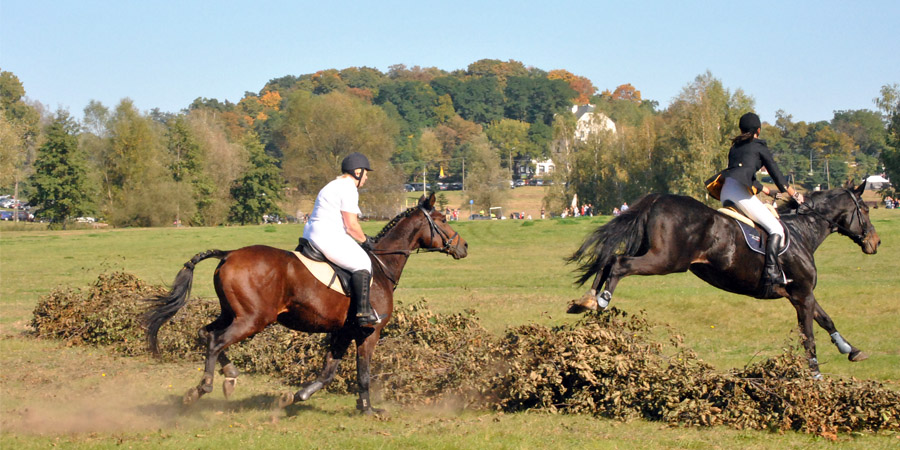
Myślęcinek, fot. S. Tyczyno
Outside the trail:
A total of 96 national natural landmarks can be found in Bydgoszcz. Some of these landmarks grow in the city centre, including:
→ Silver maple at 1 Mikołaja Kopernika Street
→ Ginkgo at 2 Gimnazjalna Street
→ Tree of heaven in Jagiellońska Street, in front of the Regional Office
→ Ginkgo at the corner of Jagiellońska and Konarskiego Streets
→ “Bartek” Oak, which should be mentioned here, despite the fact that it doesn’t grow in the city centre, but is the oldest tree in Bydgoszcz, dating back over 500 years. It grows in the proximity of the crossing of Toruńska and Sporna Streets.









